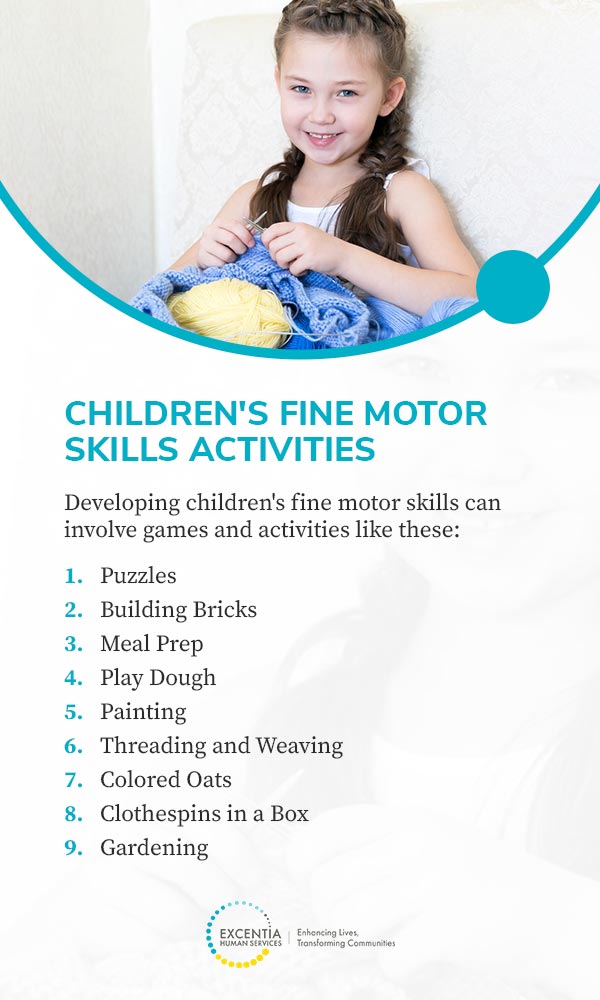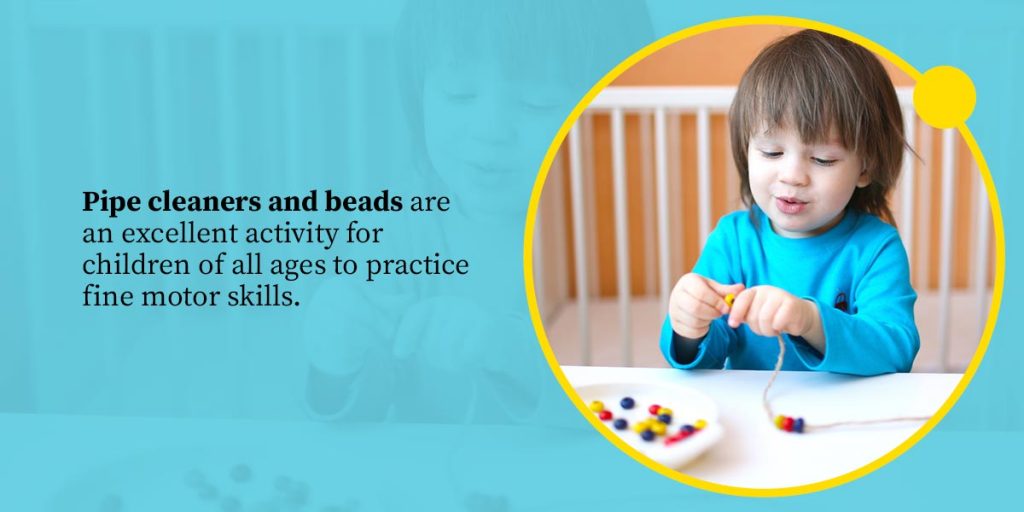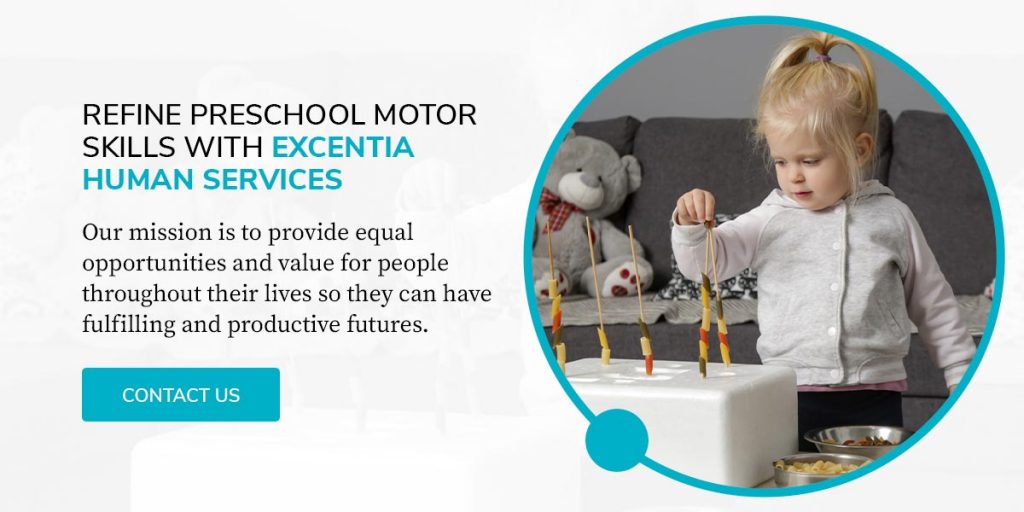
Fine motor skills describe a child’s ability to use their small muscles, such as those in their fingers, hands and wrists, while coordinating with their eyes. These skills include tasks that require dexterity, control and strength, like holding small objects, buttoning clothes and writing.
Fine motor skills are beneficial for everyday functions, and children can practice and hone these skills to strengthen their muscles and coordination. There are many activities you can perform with your child to engage them with tasks and develop their skills at any stage of their development. From inviting your child to play with blocks to teaching them to grow a flower, you can promote their developmental growth.
Importance of Fine Motor Skills
Fine motor skills are useful for most school and life activities. These skills often improve with repetition and practice, so working with your child from a young age can help them master tasks sooner. Accomplishing these fine motor skill tasks can help boost a child’s self-confidence and raise their self-esteem.
Without these skills, children may have difficulty eating, using a computer, writing, turning book pages or grooming and dressing themselves. Children who experience difficulty performing fine motor tasks can become upset and frustrated with everyday activities. They may begin to avoid these tasks, making mastery more challenging.

Fine Motor Development and Milestones
A child’s fine motor skill development often occurs over the first few years of life. Although every child will develop at their own pace, there are milestones you should watch out for and take note of. As your child ages, you can track their progress and give them the guidance they need to stay on track or get ahead.
Fine motor milestones include:
- Birth to 1 year: Newborns are typically capable of primitive grasping, and by 2 months, they can often hold an object such as a rattle if you place it in their hands. Around 4 to 6 months, your child may be able to shake a rattle or hold a block with both hands, and they may begin reaching for objects to put in their mouths. Later in the first year, children can often move an object from one hand to another and control their object release.
- 1 to 2 years: Between 12 and 24 months, children are usually interested in stacking cups and blocks. They might begin to scribble with crayons and move their entire arm to paint. They may start to eat with their fingers, requiring little to no assistance.
- 2 to 3 years: At this age, children may start drinking from an open cup and use spoons and forks to eat. Kids in this age group often start flipping single pages in books, snipping paper with scissors and using one hand consistently during play activities. They might also take off socks and shoes and undress with little to no assistance.
- 3 to 4 years: A 3-year-old might start stacking blocks into higher formations or roll clay into balls. They might begin drawing circles while holding writing utensils with their fingers and thumb rather than their fists. Kids this age might also be able to dress themselves, including unbuttoning some buttons. Additionally, you may notice your child using their non-dominant hand to stabilize objects.
- 4 to 5 years: At 5, your child may be able to color in the lines or be able to copy a square. They may write their name and numbers up to five, get dressed on their own and use scissors to cut along a dotted line continuously.
Every child will develop at their own rate. Some children will need additional practice refining their fine motor skills or may exhibit these skills later in their development. Preschool-age children who need additional encouragement could benefit from an individualized educational preschool program where instructors meet their needs and learning styles.
Children’s Fine Motor Skills Activities
Fine motor skills can improve with practice and refinement, and knowing how to teach fine motor skills to preschoolers can help them develop and hone the skills they’ll need for the rest of their lives.
There are many ways to work to improve fine motor skills in preschoolers, and you can do many of them at home. Whether you’re looking for ways to get ahead or trying to find some occupational therapy fine motor activities for preschoolers, there are plenty of at-home items that can engage your child.

To help your child further develop their skills and practice performing everyday tasks, you can implement fine motor play activities that are fun and challenging. Developing children’s fine motor skills can involve games and activities like these:
1. Puzzles
Puzzles are an excellent way to develop a child’s pincer grasp. To grab puzzle pieces and place them, your child can learn to grab and hold objects with their thumb and pointer finger.
Puzzles can be challenging for children, and they may want to give up or become impatient. They may also put pieces in their mouth, toss them under the table or lose them under other furniture. When your child is working with puzzles, you should always watch them to ensure they don’t swallow any pieces and encourage them to keep going.
Large puzzles that consist of only a few pieces would be best to start with. After your child masters this task, you can introduce more complex puzzles that help further their hand-eye coordination. As a bonus, you and your child can experience a sense of satisfaction from completing a puzzle.
2. Building Bricks
Building bricks for little kids, like Mega Bloks or Lego DUPLO, encourage creativity while prompting your child to practice pulling and pushing. You can stack, build and connect things together with your child and watch as they create new masterpieces. Picking up and building with these blocks requires children to use their hand muscles, which can also help establish a form for holding pencils and utensils.
Playing with building bricks also helps build a sense of persistence as your child comes up with new mental maps and configures blocks in new ways. They can feel a sense of accomplishment at completing a large structure and improve their problem-solving ability. Children can also develop a sense of storytelling by imagining villains, heroes, adventures and animals.
3. Meal Prep
You can help improve your child’s fine motor skills while introducing them to everyday tasks and chores. Children typically enjoy imitating family members and adults, so asking them to set the table is a great way to hone their skills and include them in family practices they enjoy. This task requires them to use hand muscles and practice placing items rather than dropping them. They can also actively work on memorization as they will be repeating the job every day and only need one of each item for every seat at the table.
Other household meal preparation to refine your child’s skills include:
- Pouring drinks for dinner into an open cup
- Stirring, shaking or mixing ingredients together
- Closing and opening lids
- Wiping the table with a sponge
These activities require your child to exert control so they don’t spill food or drink and help refine the motions to complete the tasks successfully. Some of these tasks may be better suited for kids around age 5.
4. Play Dough
Clay and similar materials are a fun way to introduce your child to shapes and motions they may not otherwise experience. You can encourage them to roll the dough into balls or snakes and prompt them to pinch, squeeze and stretch the material to work with it. This is also a great time to introduce play scissors, so your child can safely work with this tool.
The squishing and poking your child does can help strengthen their muscles and improve their hand-eye coordination to manipulate the material the way they want. This activity also engages the imagination and boosts creativity. As children work with different colors, they can make new objects that model everyday items such as food and plates. You can even introduce your child to math and science by making your own play dough or colorful slime.
5. Painting
Various types of paint can refine motor skills. For example, finger painting is an opportunity for young children to work directly with their hands to get creative and messy. Using brushes to create masterpieces teaches children how to control instruments and practice holding utensils. You can use paint-by-numbers to engage your child further to practice working between lines.
As your child decides which color to use and how bold to make their strokes, they begin problem-solving and exercising control. Additionally, painting can give them a creative outlet and encourage them to visualize their feelings through art. Painting also helps relieve stress and build self-esteem.

6. Threading and Weaving
Pipe cleaners and beads are excellent materials for children of all ages to practice fine motor skills. Older children can use strings and elastic bands to craft necklaces and bracelets for themselves or family members. They will be making decisions about the colors and shapes they want to use, and they can start practicing how to spell by using lettered beads.
Weaving with yarn and cardboard introduces the same skill but can give children more creative options for designs. By cutting a shape out of cardboard and placing a hole in the center, your child can weave and twist yarn through to create colorful hearts, circles, diamonds and squares.
Both of these activities teach control, and your child can use both hands to hold the materials steady as they twist the pipe cleaners and maneuver the yarn.
7. Colored Oats
Making an activity of colored oats is a great way to introduce your child to many new tasks. To make colored oats, You need oats, food coloring and a plastic bag for each color. Have your child measure a cup of oats into each bag, then drop about 10 drops of food coloring into each one to make them vibrant.
You can then encourage your child to color Styrofoam cups to correspond with each colored bag. This part of the activity can take some time if you encourage them to get creative with stickers and paint, as well. Once the cups are dry, pour the oats into a plastic container, keeping the colors as separate as possible. You can then add colorful marshmallows, beads or other colorful objects on the oats of different colors.
Then, give your child a clothespin to route through the oats to find all the objects. As they discover a purple bead or green marshmallow, they can use the clothespin to pick it up and drop it into the correct cup. This activity can teach them how to hold utensils, engage them with picking up and releasing objects in a controlled manner and give them a fun way to interact with colors.
8. Clothespins in a Box
A box and clothespins can create hours of fun and skill honing. Begin the activity by having your child decorate a box with paint and crayons. You can find fun stencils for them to trace and practice working in the lines or encourage them to write their name and draw their favorite animal.
For this clothespin activity, there are many ways to use and reuse the box. You can use pieces of tape to add letters, colors or numbers on the box. Then, use tape or stickers for the end of the clothespins to correlate with what you wrote on the box. Your child will search the box looking for the match to their clothespin and practice holding objects and placing them in a precise location.
9. Gardening
Gardening is an excellent way to get your child outside and breathing in the fresh air. Planting and growing flowers and vegetables get kids outdoors and introduce them to a valuable life skill. This activity can develop their fine motor skills while giving them a healthy way to exercise and get in touch with nature.
Although planting and gardening also engage gross motor skills, there are plenty of tasks that require your child’s small muscles in your backyard. Gardening and digging require control. When your child moves a seedling into the soil, they must use hand-eye coordination to carry the plant without harming it. They will need to use a pincer grab to pick up seeds and understand how to grasp digging tools.

Refine Preschool Motor Skills With Excentia Human Services
Excentia Human Services helps young children develop fine motor, social and academic skills. We offer inclusive preschool programs where children with individualized education plans (IEPs) can receive an education alongside their peers. Each child will receive specialized instruction and physical, speech and occupational therapies specific to their needs.
Our mission is to provide equal opportunities and value for people throughout their lives so they can have fulfilling and productive futures. Our classrooms have more staff and fewer children than most in the county, so we can be sure we meet the educational needs of every student by using unique approaches to meet different learning styles.
With over 50 years of service in Lancaster County, Pennsylvania, we’ve spent years developing unique services that stretch across the life span. Contact us to learn more about our unique program and how we can help develop your preschooler’s fine motor skills.

